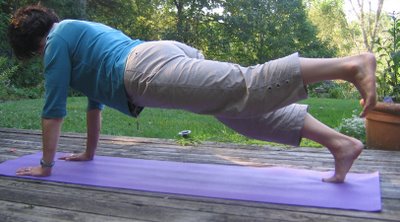Thursday, August 23, 2007
Have a Look...
Soul Jerky: YogaDawg-ish irony with lots of interesting links to yoga-related (sorta) articles, nice design
Isha Yoga: a snappy blog, with some very funny observations--most recently about nude yoga
Playin' the Edge: some nice observations about her own practice, quotes and sequencing ideas
Yoga, Dogs and Chocolate: a personal blog with topics ranging from yoga to vacation photos to reading lists
Yoga Buzz: Yoga Journal posts news from the yoga world...some of the discussions get quite heated
Let me know if you have any favorites that we should consider!
Saturday, August 18, 2007
In Remembrance of Things Past...
Maybe I am just torturing myself, but I thought it might be nice to think about Plank and some variations for a few days. I haven't offered much in the way of Yoga Practice lately, and its always good to pay some attention to the core. Of course, I'm not doing anything abdominal right now--or maybe I am only doing abdominal work, depending how you look at it (the Youngster is due in 2 weeks)--but I am looking forward to the future.
Here's a little something to hold you (borrowed from last summer)...for the next post I want to talk about vairagya (non-attachment) again and will be back to more Thoughts.
Variations for Plank Pose
Basic Plank: Set up in Table Pose as you would for Dog; heels of the hands are beneath the shoulders, knees are beneath the hips. From here, straighten the arms and stretch the legs out behind to bring the torso into a straight line from the ankles to the shoulders. Keep the shoulders away from the ears and the neck long. Notice the work in the torso--the abdominals do most of the work in this pose, more than the arms and legs, because they are responsible for keeping the spine long and the torso lifted. If your hips sag, or the body is bent, lower one or both knees to the floor, so that the abs are still engaged, but you can lengthen the back. Try to hold for 5 breaths and work up to 10.


©Brenda K. Plakans. All Rights Reserved.
Monday, August 13, 2007
Blogging as a Yoga Practice
I’ve been a self-publisher from an early age. In fourth grade I put out a monthly newsletter call Brenda’s Bugle that featured such goodies as book reviews, 4-clue crossword puzzles, some cartoons cribbed from the New Yorker and a contest that my grandmother always won (I knew she wouldn’t collect the prize money—usually a dollar). There was also a two-issue modern dance “magazine” that I forced my sister to subscribe to and a fanzine some friends and I intended to start in high school, but just ended up borrowing some disks from the campus record store with the intension of reviewing them (I wrote the reviews but never got around to printing them…or returning the records).

Monday, August 06, 2007
Witnessing the Voices
Some interesting ideas have come up lately, both from my interviews for the “Ego and Teaching” article and in my readings on Pranayama. In the last couple of posts, I’ve been talking about other yoga practices besides asana, so I’m still thinking about that, too (so have some readers, check out the comments sections to see what Stella, Kristin and Gypsy Girl have offered about their non-asana practice).

Friday, August 03, 2007
Ego preview...
This all goes along with my current yoga-is-not-just-asana kick. So I have a lot more to say about expanding your yoga practice, but I need to do a bit more thinking. On Monday I'll start sharing these reflections.
Have a great weekend!
